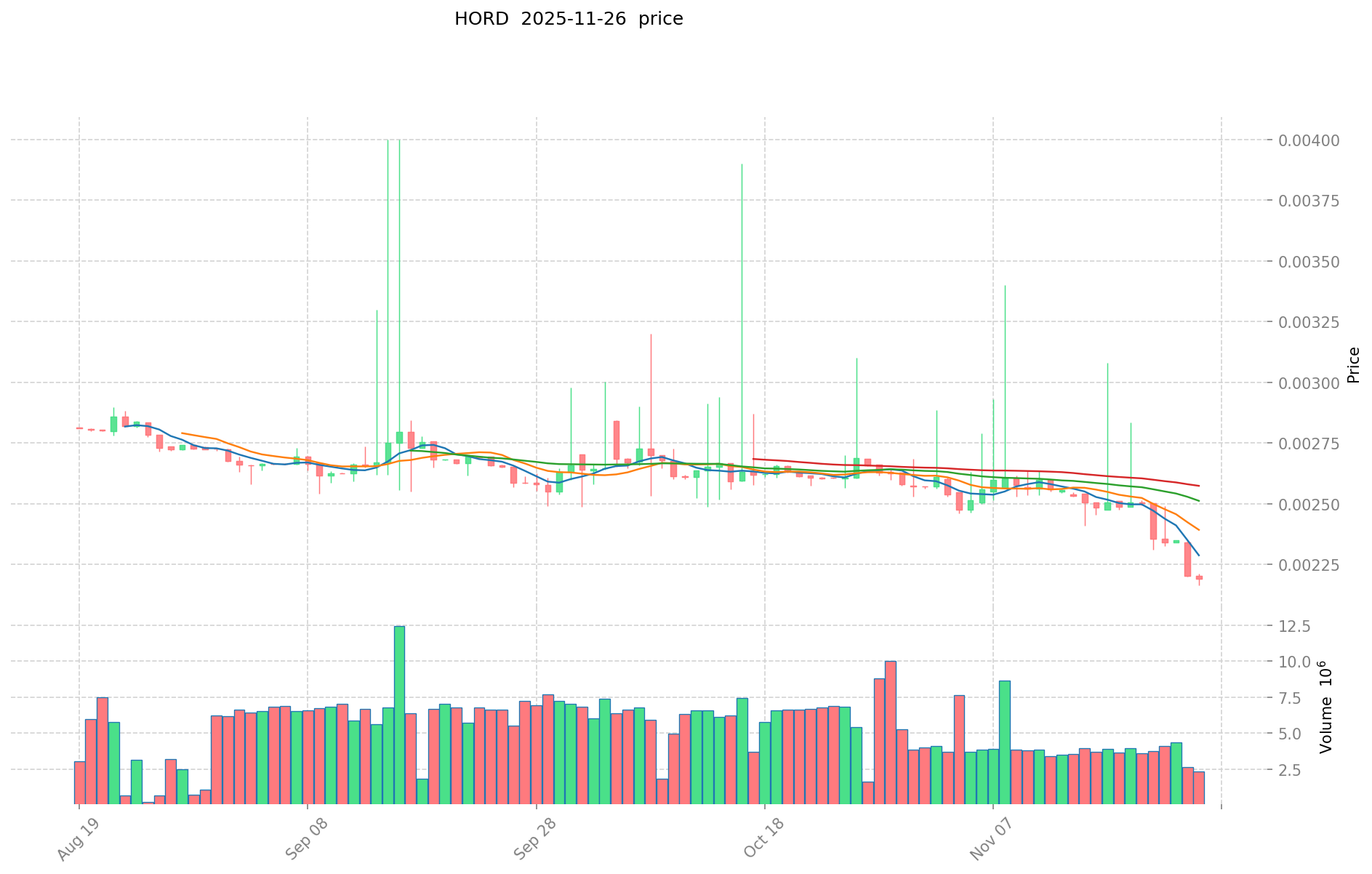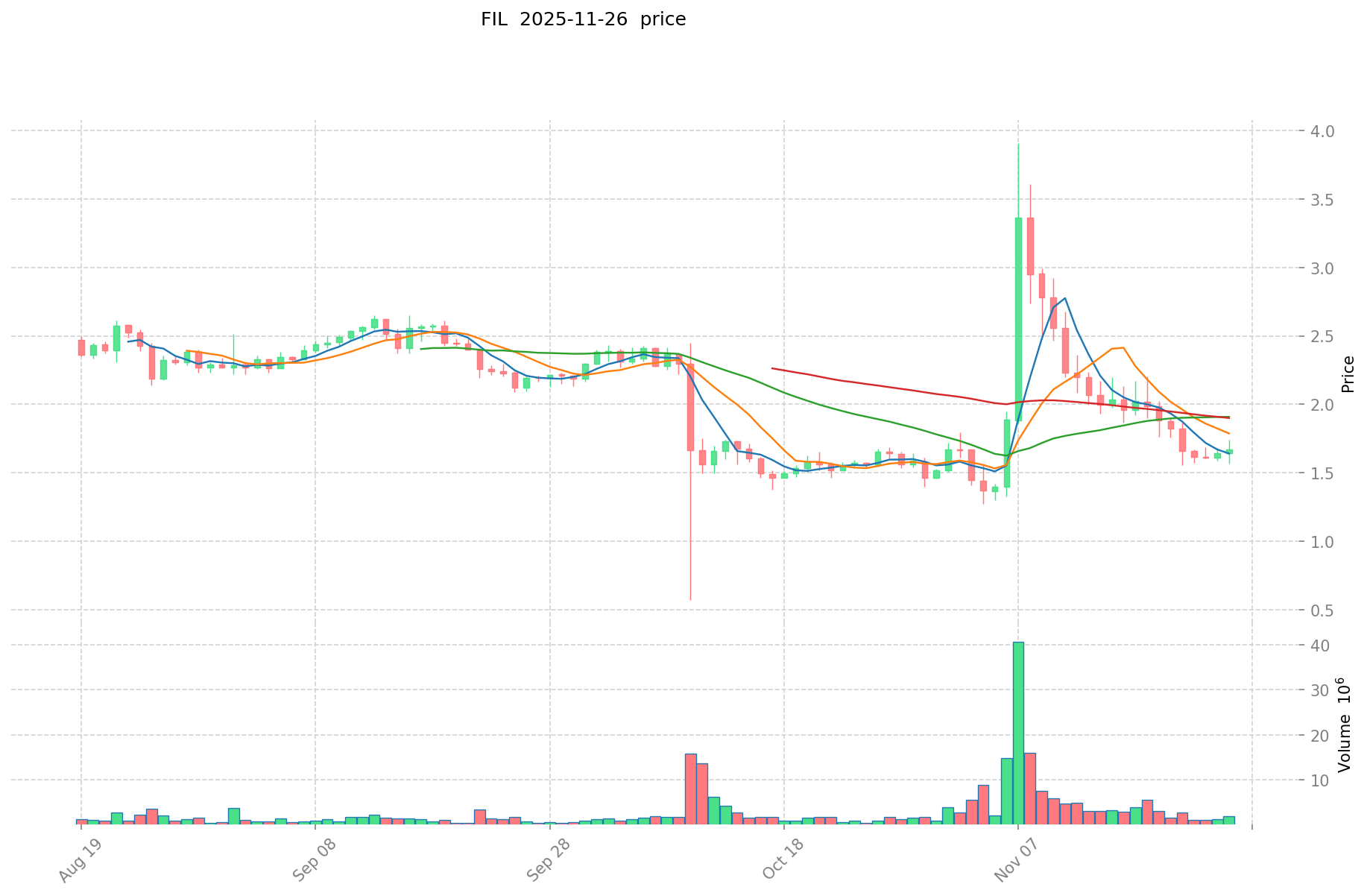HORD vs FIL: Comparing Two Innovative Blockchain Storage Solutions
Introduction: HORD vs FIL Investment Comparison
In the cryptocurrency market, the comparison between HORD and FIL has always been a topic that investors can't avoid. The two not only show significant differences in market cap ranking, application scenarios, and price performance, but also represent different positions in crypto assets.
Hord (HORD): Since its launch in 2021, it has gained market recognition for enabling cryptocurrency professionals to tokenize and monetize their influence.
Filecoin (FIL): Launched in 2020, it has been hailed as a decentralized storage network, and is one of the cryptocurrencies with the highest global trading volume and market capitalization.
This article will comprehensively analyze the investment value comparison between HORD and FIL, focusing on historical price trends, supply mechanisms, institutional adoption, technological ecosystems, and future predictions, and attempt to answer the question that investors care most about:
"Which is the better buy right now?"
I. Price History Comparison and Current Market Status
HORD (Coin A) and FIL (Coin B) Historical Price Trends
- 2021: HORD reached its all-time high of $1.79 on May 12, 2021.
- 2021: FIL achieved its all-time high of $236.84 on April 1, 2021.
- Comparative analysis: In the recent market cycle, HORD dropped from its high of $1.79 to a low of $0.00179628, while FIL declined from $236.84 to a low of $0.848008.
Current Market Situation (2025-11-27)
- HORD current price: $0.002191
- FIL current price: $1.664
- 24-hour trading volume: HORD $11,688.81 vs FIL $2,581,539.06
- Market Sentiment Index (Fear & Greed Index): 20 (Extreme Fear)
Click to view real-time prices:
- View HORD current price Market Price
- View FIL current price Market Price


II. Core Factors Affecting HORD vs FIL Investment Value
Supply Mechanisms Comparison (Tokenomics)
- HORD: Fixed total supply of 320 million tokens with 160 million currently circulating in the market.
- FIL: Inflationary model with a maximum cap of 2 billion tokens, featuring block rewards that adjust based on network storage capacity.
- 📌 Historical Pattern: Fixed supply tokens like HORD tend to have higher price volatility in bull markets, while FIL's adjusted emission rate creates more predictable supply increases tied to network growth.
Institutional Adoption and Market Applications
- Institutional Holdings: FIL has garnered more significant institutional interest with Grayscale's Filecoin Trust and integration with institutional storage solutions.
- Enterprise Adoption: FIL has established partnerships with major Web3 storage providers and enterprise clients, while HORD's adoption remains primarily in the DeFi portfolio management segment.
- Regulatory Attitudes: Both tokens operate in regulatory gray areas in most jurisdictions, with FIL's utility-focused approach potentially providing more regulatory clarity than HORD's investment-oriented services.
Technical Development and Ecosystem Building
- HORD Technical Development: Focus on portfolio management infrastructure and DeFi tooling for traders and asset managers.
- FIL Technical Development: Continuous improvements to the decentralized storage network, with upgrades to enhance retrieval efficiency and reduce costs.
- Ecosystem Comparison: FIL has a more diverse ecosystem spanning storage, NFT marketplaces, and data services, while HORD is more narrowly focused on DeFi portfolio management and trading tools.
Macroeconomic Factors and Market Cycles
- Inflation Environment Performance: FIL's utility as infrastructure potentially offers better value preservation during inflationary periods compared to HORD's investment management focus.
- Monetary Policy Impact: Both tokens show sensitivity to broader crypto market trends influenced by monetary policy, with FIL showing slightly more resilience during tightening cycles.
- Geopolitical Factors: FIL's decentralized storage use case may benefit from increased data sovereignty concerns globally, while HORD remains more exposed to overall DeFi market sentiment.
III. 2025-2030 Price Prediction: HORD vs FIL
Short-term Prediction (2025)
- HORD: Conservative $0.00135408 - $0.002184 | Optimistic $0.002184 - $0.00238056
- FIL: Conservative $1.37946 - $1.662 | Optimistic $1.662 - $1.94454
Mid-term Prediction (2027)
- HORD may enter a growth phase, with prices estimated between $0.0019513494 and $0.003408356952
- FIL may enter a bullish market, with prices estimated between $1.77441768 and $2.373283647
- Key drivers: Institutional capital inflow, ETF, ecosystem development
Long-term Prediction (2030)
- HORD: Base scenario $0.003729902907931 - $0.004065594169645 | Optimistic scenario $0.004065594169645+
- FIL: Base scenario $2.8769121810702 - $4.286599149794598 | Optimistic scenario $4.286599149794598+
Disclaimer: This analysis is based on historical data and market projections. Cryptocurrency markets are highly volatile and unpredictable. This information should not be considered as financial advice. Always conduct your own research before making investment decisions.
HORD:
| 年份 | 预测最高价 | 预测平均价格 | 预测最低价 | 涨跌幅 |
|---|---|---|---|---|
| 2025 | 0.00238056 | 0.002184 | 0.00135408 | 0 |
| 2026 | 0.0029213184 | 0.00228228 | 0.0012780768 | 4 |
| 2027 | 0.003408356952 | 0.0026017992 | 0.0019513494 | 18 |
| 2028 | 0.00342578900664 | 0.003005078076 | 0.0018030468456 | 37 |
| 2029 | 0.004244372274542 | 0.00321543354132 | 0.001736334112312 | 46 |
| 2030 | 0.004065594169645 | 0.003729902907931 | 0.002088745628441 | 70 |
FIL:
| 年份 | 预测最高价 | 预测平均价格 | 预测最低价 | 涨跌幅 |
|---|---|---|---|---|
| 2025 | 1.94454 | 1.662 | 1.37946 | 0 |
| 2026 | 2.6327742 | 1.80327 | 0.9377004 | 8 |
| 2027 | 2.373283647 | 2.2180221 | 1.77441768 | 33 |
| 2028 | 3.236870551635 | 2.2956528735 | 1.905391885005 | 37 |
| 2029 | 2.9875626495729 | 2.7662617125675 | 2.517298158436425 | 66 |
| 2030 | 4.286599149794598 | 2.8769121810702 | 1.639839943210014 | 72 |
IV. Investment Strategy Comparison: HORD vs FIL
Long-term vs Short-term Investment Strategies
- HORD: Suitable for investors focused on DeFi portfolio management and trading tools
- FIL: Suitable for investors interested in decentralized storage infrastructure and long-term utility
Risk Management and Asset Allocation
- Conservative investors: HORD: 20% vs FIL: 80%
- Aggressive investors: HORD: 40% vs FIL: 60%
- Hedging tools: Stablecoin allocation, options, cross-currency portfolios
V. Potential Risk Comparison
Market Risks
- HORD: Higher volatility due to smaller market cap and narrower focus
- FIL: Susceptible to fluctuations in demand for decentralized storage
Technical Risks
- HORD: Scalability, network stability
- FIL: Mining power concentration, security vulnerabilities
Regulatory Risks
- Global regulatory policies may have different impacts on both tokens, with FIL potentially facing less scrutiny due to its utility-focused approach
VI. Conclusion: Which Is the Better Buy?
📌 Investment Value Summary:
- HORD advantages: Niche focus on DeFi portfolio management, potential for high growth in bull markets
- FIL advantages: Established decentralized storage network, broader ecosystem, institutional interest
✅ Investment Advice:
- Novice investors: Consider a small allocation to FIL as part of a diversified crypto portfolio
- Experienced investors: Balanced approach with both HORD and FIL, adjusting based on market conditions
- Institutional investors: Higher allocation to FIL due to its established network and potential for enterprise adoption
⚠️ Risk Warning: The cryptocurrency market is highly volatile, and this article does not constitute investment advice. None
VII. FAQ
Q1: What are the main differences between HORD and FIL? A: HORD focuses on DeFi portfolio management and trading tools, while FIL is a decentralized storage network. HORD has a fixed supply of 320 million tokens, whereas FIL has an inflationary model with a maximum cap of 2 billion tokens. FIL has gained more institutional interest and has a broader ecosystem.
Q2: Which cryptocurrency has shown better price performance historically? A: Both HORD and FIL reached their all-time highs in 2021. HORD's peak was $1.79 on May 12, 2021, while FIL reached $236.84 on April 1, 2021. However, FIL has maintained a higher price and market capitalization overall.
Q3: How do the supply mechanisms of HORD and FIL differ? A: HORD has a fixed total supply of 320 million tokens, with 160 million currently circulating. FIL uses an inflationary model with a maximum cap of 2 billion tokens, where block rewards adjust based on network storage capacity.
Q4: Which cryptocurrency is more suitable for long-term investment? A: FIL may be more suitable for long-term investment due to its established decentralized storage infrastructure, broader ecosystem, and higher institutional interest. However, the choice depends on individual investment goals and risk tolerance.
Q5: What are the main risks associated with investing in HORD and FIL? A: For HORD, risks include higher volatility due to a smaller market cap and narrower focus, as well as potential scalability issues. FIL faces risks related to fluctuations in demand for decentralized storage, mining power concentration, and potential security vulnerabilities.
Q6: How do institutional adoptions compare between HORD and FIL? A: FIL has garnered more significant institutional interest, with products like Grayscale's Filecoin Trust and integration with institutional storage solutions. HORD's adoption remains primarily in the DeFi portfolio management segment.
Q7: What are the price predictions for HORD and FIL by 2030? A: Based on the provided predictions, by 2030:
- HORD's base scenario is $0.003729902907931 - $0.004065594169645, with an optimistic scenario above $0.004065594169645.
- FIL's base scenario is $2.8769121810702 - $4.286599149794598, with an optimistic scenario above $4.286599149794598. However, these predictions are speculative and subject to market volatility.
Share
Content